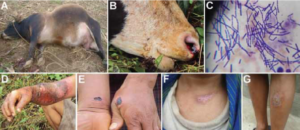Anthrax is a contagious disease caused by Bacillus anthracis bacteria. Anthrax is found in wild and domestic animals in the world, especially in cattle, sheep, goats, camels and antelopes. In humans, It usually occurs when they are exposed to bacteria by touching animals or animal hides. There are three forms of anthrax infection: cutaneous (skin), inhalation (lungs) and gastrointestinal (stomach).
Recently, it has been reported that it has spread by drugs or contaminated heroin tablets and used as a biological weapon. Although anthrax can be found worldwide, it is more common in agricultural areas where animal husbandry is practiced. It is particularly common in developing countries or in countries without veterinary public health programs. Anthrax is reported more frequently in South and Central America, South and Eastern Europe, Asia, Africa, the Caribbean and the Middle East. However, it should be kept in mind that anthrax is one of a number of potential agents that can be used in biological terrorism. It can be found in domestic and wild animals such as cattle, sheep, goats, antelopes and deer, contaminated soils, plants; or in water as infected. Anthrax usually spreads in the form of sports. Most people who are exposed to anthrax get sick within a week, but inhalation anthrax can last up to 42 days.
Skin (Cutaneous) Form: Most anthrax infections occur when people contact animals such as wool, bone, meat, etc. . Infection occurs when bacteria have a cut or scratch on the skin. Skin form is the most common form of anthrax.The first symptoms occur with itching of the skin. If the wound is not treated, the infection can spread to the lymph nodes and the bloodstream.
Respiratory (Lung) Form: Some anthrax infections occur when inhaled. The first symptoms in the form of inhalation occur as fever, fatigue, weakness and cough or chest pain. High fever, rapid pulse, and difficulty breathing occur within two to five days. Inhalation anthrax is usually fatal.
Gastrointestinal (Stomach, Bowel) Form: Anthrax occurs when some people eat contaminated meat that is not cooked properly. The first symptoms in the gastrointestinal form include fever, severe abdominal pain, loose, watery bowel movements, bloody diarrhea, and vomiting with blood.
Anthrax disease in grazing animals is seen as sudden death, weakness, difficulty breathing. In addition, it usually comes from natural holes. Blood stains are seen after death and the animal which is anthrax quickly decomposes.
After the spread of such infectious diseases, unfortunately, people who do not have technical knowledge about the disease give various statements to the press and society is misinformed. One of them is the claim that anthrax is transmitted from person to person. Anthrax does not spread from person to person by respiratory (daily contact, coughing, sneezing). Only an open wound can pose a risk of direct contact with the drainage path. Spores can remain active in nature for many years.
There are individuals who are at higher risk of being infected with anthrax. For this reason, people who are at risk, such as veterinarians, farmers, slaughterhouses and workers working here, people travelling to areas where anthrax is endemic, companies operating animal products, personnel working in laboratories, military personnel, biota or people trained to respond to biological warfare should be more cautious in zoonotic diseases.
The cadavers of the sudden dead animals should be buried in deeply opened pits, away from water sources, and also lime or antiseptics should be poured on top of them. Provincial and district directorates should be immediately notified as soon as deaths occur.
Anthrax is diagnosed when the Bacillus anthracis bacteria is present in the blood, skin lesions, or respiratory secretions with a laboratory culture. It can also be detected by measuring specific antibodies in the blood of infected persons. There are several antibiotics used successfully to treat anthrax. It is very effective in cases of skin anthrax. If treatment is started early, inhalation and gastrointestinal anthrax may also be effective. If you are exposed to anthrax skin, wash your hands thoroughly with soap and water to prevent infection. Similarly, washing the laundry can be a safe way to get rid of any possible anthrax. It should be noted that medical assessment and treatment are needed in a possible case where spores are inhaled.
Usually flu-like symptoms (fever, chills, cough, nausea, vomiting and body aches) are seen. Depending on the type of infection it may occur within a period of one day to two months. When you see anthrax symptoms, you need to act as quickly as possible to increase your chances of survival and to ensure complete recovery and to see medical treatment. Early diagnosis and treatment is very important.




